Choosing the Best Puppy in a Litter
By Michele Welton, Dog Trainer, Breed Selection Consultant, Author of 15 Dog Books
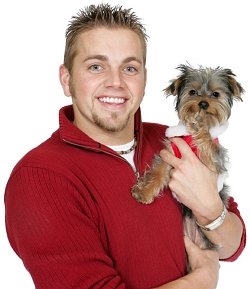
Don't just grab the "cutest" puppy or the boldest one. Use my sensible guidelines for choosing a puppy to be a good family pet.
Here's my first tip for choosing the puppy who is best suited to you: Don't let the PUPPY choose YOU.
You may have been advised by well-meaning friends to "Pick the puppy who runs right up to you!"
But this simply results in all the bold and pushy puppies being chosen first. The gentler puppies who wait politely in the background get ignored.
Most families are making a mistake when they choose bold, vigorous, energetic puppies who jump all over you, grab all the toys, start all the wrestling matches, grab hold of your pants leg and tug fiercely with adorable puppy growls.
Sure, these little dynamos are a blast to play with – for an hour at the breeder's house. But they can drive you crazy within a day or two in your own home. And they can be more difficult to train.
A puppy can be perfectly suited to you without launching himself into your lap. Before you choose, resolve to give each pup a fair shake.
First, evaluate the litter as a group
Your first look should be at the litter as a group. If there are four puppies and three of them are staying at arm's length or woofing suspiciously at you, this is probably a very risky litter.
And what about the fourth puppy, the one who acts normal? I would be still be wary. He could have inherited the same shy or distrustful genes and it simply hasn't caught up to him yet.
 A puppy who tucks his tail or shrinks away from you is not a safe choice as a pet. This is especially true if you have children. If the shyness is hardwired into his genes, a shy puppy will grow into a shy adult who can be difficult to live with and who may even snap defensively if startled or frightened.
A puppy who tucks his tail or shrinks away from you is not a safe choice as a pet. This is especially true if you have children. If the shyness is hardwired into his genes, a shy puppy will grow into a shy adult who can be difficult to live with and who may even snap defensively if startled or frightened.
So if the litter isn't running away, what should they be doing?
Normal puppies are friendly, curious, and trusting. They mill around your feet, tug at your shoelaces, crawl into your lap, nibble on your fingers, and just generally toddle around checking everything out.

Observe how each puppy plays with the other puppies.
You can tell something about the individual puppies by the way they interact with their littermates.
- Which ones are strong, bold, bossy, noisy?
- Which ones are quiet, submissive, gentle?
- Which ones grab all the toys and win the tugs-of-war?
- Which ones seem delicate or picked on?
Most families do best with a pup who is neither boss of the litter nor lowest on the totem pole.
Next, evaluate the puppies individually
After viewing the pups as a group, ask the breeder if you can see each pup who is available for sale, individually. If would be ideal if this could be a room where he hasn't been before.
This is an important step in evaluating puppies. You want to see how each pup reacts when he is away from his littermates. After all, that's how it's going to be at your house.
- Sometimes a puppy who seems confident when his friends are "backing him up" will become less certain on his own.
- Sometimes a quiet puppy who feels dominated by the others will become more outgoing and playful on his own.
- Sometimes a hyperactive puppy will calm down when not being egged on by the others.
11 temperament tests (for pups 7-12 weeks old)
(1) Put the puppy down in the new room and observe him.
- Does he explore? Or is he taken aback by this unexpected turn of events, and if so, how long does it take him to get over his uncertainty and start poking around?
- Does he keep his tail mostly up or mostly down? Is it wagging?
(2) Purse your lips and make a funny sound, or cluck your tongue.
- Is he alert? Interested? Does he come over to investigate?
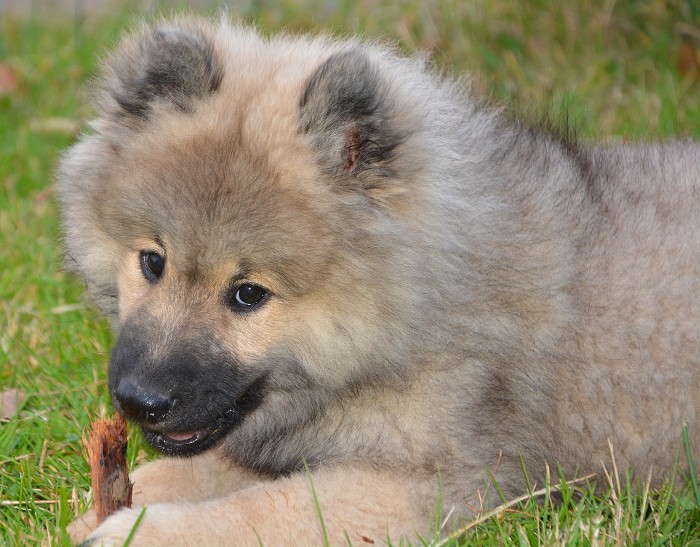
(3)Jingle your car keys.
- Is he curious, or frightened?
(4) Hold the keys out to him or place them on the floor.
- Does he come over to investigate? Or is he wary and distrustful?
You want an attentive, confident puppy. A nervous puppy who is afraid of sudden sounds or quick movements will not do well in a normal household. A puppy who is completely oblivious may be too dull-witted or too independent – or sick.

(5) See how he reacts to being handled.
- Is he okay when you guide him into a sit position, then into a lying down position?
- Is he okay when you feel around his ears, as though you were cleaning them?
- Is he okay when you pick up a front foot and feel around his toes, as though clipping his nails?
- Is he okay when you gently lift his lip and touch his little teeth?
It's normal for a puppy to struggle a little, or to lick or mouth or nibble at your fingers. But he shouldn't become panicky, or growl or bite.
(6) See how he reacts to being picked up.
- Is his body pliable and relaxed? Or does he tense up or throw out all four limbs like a car-window, suction-cup Garfield?
(7) Call the puppy and encourage him to come to you.
After you've placed the puppy back on the floor, wait until he has wandered away from you. Then kneel down and clap your hands a few times, gently and softly and down close to the floor, in an encouraging manner.
- A normal puppy should come readily to you and show confidence when he arrives.
- A bold/dominant puppy may rush wildly at you, jumping on you or mouthing your hands.
- A submissive puppy will come hesitantly, often with his tail down or his belly low to the ground.
- An independent puppy will ignore you, or will glance at you but keep on doing his own thing.
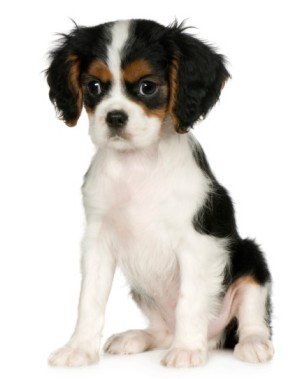
(8) Walk around the room, encouraging the pup to follow you.
Stand up and walk away from the puppy, bending down as you walk and gently clapping or rubbing your hands to encourage him to follow.
- A normal puppy will follow you.
- A bold/dominant puppy will, too, but he'll entangle your feet, or pounce on your shoes, or try to grab your pant leg, or make a lot of noise.
- A submissive puppy will follow hesitantly with his tail down.
- An independent puppy will just stand there watching you leave, or will wander off to explore.
(9) Gently roll the puppy onto his back and hold him there, with one hand on his chest, for fifteen seconds.
- A normal puppy will struggle a little, then settle down.
- A submissive puppy will freeze in position, or lie passively without any struggle, perhaps licking your fingers.
- A bold/dominant or independent puppy will struggle fiercely the whole time, perhaps crying or trying to nip.
(10) Lace your fingers together and cradle them, palms up, under the puppy's tummy. Raise him up just a little bit, so that his four feet are just off the floor. Hold him there for fifteen seconds.
- A normal puppy will struggle a little, then settle down.
- A submissive puppy will freeze in position, or hang passively without any struggle, perhaps even licking your fingers.
- A bold/dominant or independent puppy will struggle fiercely the whole time, perhaps crying or trying to nip.
(11) Get the puppy's attention with a ball or toy. Roll it across the floor and encourage the puppy to run after it and bring it back. Repeat several times.

- An EXCELLENT puppy will actually bring it back to you (or most of the way back), and can be enticed to drop it.
- A normal puppy will chase it and pick it up but then carry it away rather than bring it back to you. When you walk over to him so you can get it, he IS willing to release it.
- A bold/dominant puppy will carry it away and hold onto it, perhaps even growling and tugging fiercely, when you go over to get it from him.
- A submissive or nervous puppy may be startled when the toy rolls by, or may be hesitant to approach the toy when it stops moving.
- An independent puppy (or one who simply has no chasing instincts) will show little or no interest in the moving toy.
How to use the results of temperament tests
Most families, especially those with kids, will do best with a puppy who behaves normally in most of the tests.
- A pup who displays a lot of bold, dominant, or independent behaviors may be more difficult to train.
- A pup who displays a lot of submissive or nervous behaviors will need careful socialization, else he could mature into a skittish adult.
- A pup who is a real mixed bag (some tests normal, some bold/dominant, some submissive, some independent) may be unpredictable and hard to "read".

Also keep in mind the breed you're testing. If the typical temperament of the overall breed is bold, dominant, submissive, or independent, the responses of most of the pups may match that typical temperament. However, most families will still do best with a puppy whose responses lean toward the normal.
I once temperament-tested a litter of four Norwegian Elkhound pups. In 10 of the 11 tests, their responses were virtually identical to each other, and perfectly matched the bold/independent temperament of most Elkhounds. Only in the final "fetch" test did one of the pups do something unexpected, actually bringing the ball back to me. That's the pup I eventually chose.
11 health checks you can do in less than 2 minutes
EYES should be clear – not watery, crusty, or squinting. The whites of his eyes should not be yellowish or orangish. The upper and lower eyelids should not roll inward or outward. The eyelashes should curl outward. There should be no brownish tear stains at the corners of the eyes.
EARS should be clean – not dirty or smelly. He should not be shaking his head, which could mean an ear infection or mites.
NOSE may be either cool or warm, but it should not be running. You should not hear him breathing through his nose, or wheezing. He should not be sneezing (unless he just poked his nose into dust or weeds!).
TEETH should be white and strong. They should point straight up and down, and not be crowded too close together.

His BITE should be.....wait, what does BITE mean?
Bite means the way in which the pup's upper teeth and lower teeth fit together.
A scissors bite is the only healthy bite for a dog. In a scissors bite, the upper front teeth overlap the lower front teeth so snugly that the inside surface of the upper teeth touches (or nearly touches) the outside surface of the lower teeth.
This slightly-offset position keeps the teeth from grinding on top of each other when your dog closes his mouth or chews.
Less desirable bites
In a level/even bite, the upper and lower front teeth meet edge-to-edge and grind together.
As the dog ages, the grinding teeth may be worn down to the gum line. Unfortunately, many breeds are "allowed" by their Breed Standard to have a level or even bite. But "allowed" doesn't mean "healthy".
In an overshot bite, the upper jaw is considerably longer than the lower jaw, so that the upper teeth protrude over the lower teeth with a good-sized gap between them.
In people, we call this an overbite or sometimes "buck teeth". If the degree of overshot-ness is mild, this is okay. But if it's extreme, the teeth in the lower jaw can actually dig into the soft tissue in the roof of the mouth when the dog chews.
Finally, in an undershot bite, the upper jaw is shorter than the lower jaw, so that the lower teeth protrude in front of the upper teeth.
This is a very poor bite because the upper teeth can dig down into the dog's tongue or lower gums when he chews. Also, when the lower jaw juts out, the teeth often slant forward, making the bite even weaker and the teeth more likely to become loose and wiggly. As with a level/even bite, some breeds are "allowed" (or even required!) by their Breed Standard to have an undershot bite. Doesn't matter. It's unhealthy.

In a young puppy, the bite he has now may not turn out to be his adult bite. A level/even, slightly overshot, or slightly undershot bite at 8 or 10 weeks old may still correct itself into a healthy scissors bite with maturity. However, a severely overshot or undershot bite will not correct itself.
Unless you're planning to show or breed, you don't need to reject a dog with a bad bite! But you should monitor his mouth throughout his life to make sure any teeth out of alignment are not interfering with other teeth or with the soft tissue of his mouth, or with his ability to close his mouth or chew his food. If this occurs, dental surgery may be required.
Examine the SKIN thoroughly.
- Any fleas? Part the coat in several places, especially around the hindquarters. Look for the little buggers themselves, and for the dark specks of their waste, which often cling to the pup's hair. Fleas are often easiest to spot on the sparsely-coated stomach or groin. The puppy should not be scratching furiously at his coat or ears, or turning around to bite at the base of his tail.
- Look for bare patches around his eyes and mouth, and on his front legs; these would be classic signs of demodectic mange (which doesn't cause any itching).
- Look for a reddish rash on the head and neck (could be ringworm), or reddish crusty pimples in the armpits, stomach, and groin (could be sarcoptic mange); both of these conditions are usually itchy.
- Run your hands over his body, looking and feeling for any lumps or growths. Check for a bulge under the skin on the stomach or groin, or on the inner thigh of a rear leg. This could be a hernia.
ANAL AREA should be clean – no red irritated skin or brown stains, either of which suggests diarrhea. If you get lucky, you might even have a chance to observe stools for firmness.
In an unneutered male pup, feel for TESTICLES in the scrotum. A male puppy is born with them up inside his abdomen. Between 2 and 12 weeks of age they're supposed to descend into the scrotum. Sometimes one testicle will come down before the other. It's even okay if one (or both) testicles comes down, goes back up, then comes down again, especially when the puppy is excited or nervous.
But if a pup has reached 10-12 months old and one or both testicles has never come down, he should definitely be neutered, else the retained testicle has a higher risk of developing cancer.
Observe the pup's GAIT as he walks and runs around. Watch for limping or favoring a leg, or suddenly lifting one hind leg for a few moments while walking or running (this could be luxating patella, i.e. a bad knee joint that may require expensive surgery).
Finally, the most important health check
Make sure both parents of these puppies have all of the health certifications required for their breed. To find out what those should be, read my Dog Breed Reviews along with the Buying/Adopting pages of the breed you're interested in. That's where you'll find the health certifications the breeder should have done on the parents before breeding them.
For example:

Would I buy a puppy whose parents don't have the required certifications? I would not. First, because I want the best chance of my pup growing up healthy. And second, because it's irresponsible to breed dogs without the appropriate health certifications, and I won't reward irresponsible breeders with my money; that just encourages them to keep on doing what they're doing.
At this point, since we're talking about the parents of your potential pup, let's go on to....
Evaluating the temperament of the parents
Some adult dogs will be friendly and outgoing from the moment you ring the doorbell, but it's also perfectly normal for a dog to bark at you when you first come in, or to stand back and look you over. But he should soon come over to meet you.
A dog who will not approach me at all, or who keeps barking or grumbling at me from a distance, even after I've been there for 15 minutes, is not one I want for my puppy's parent.

Most dogs are bolder and noisier behind a fence, where even sweet dogs may gleefully pretend to be maniacal killers. Make sure your puppy's parents are brought OUT of their crates or kennel runs so you can meet them up close.
If the breeder is reluctant to do this... or if either parent has to be locked up because it won't calm down or won't shut up... or if either parent is totally out of control, running around wildly and ignoring the breeder's commands... or if either parent cringes away from you with its tail down or spooks if you happen to move your hand or shift your feet... I wouldn't want one of their puppies.
And don't let a breeder dismiss your concerns about a dog's temperament with excuses: "Oh, she's really very sweet, but she was abused when she was young, so she doesn't trust strangers." In truth, you have no idea if her dubious temperament was caused by a bad experience, or whether it's genetic and your puppy might have inherited it.
 Pay special attention to the MOTHER. The pups have not only inherited genes from their mother but also have spent many weeks living with her. They may have internalized her attitude toward strangers, her reactions to loud sounds, and so on.
Pay special attention to the MOTHER. The pups have not only inherited genes from their mother but also have spent many weeks living with her. They may have internalized her attitude toward strangers, her reactions to loud sounds, and so on.
(If she is still with her puppies, she may display a somewhat suspicious maternal instinct, so ask to see her away from the puppies so you can more fairly judge her temperament.
Make sure she is the confident, well-adjusted dog you want your own puppy to become.
You may be asking, "Why do I have to spend all this time evaluating the adults when I want to buy a puppy?" Canine authority Roger Caras wisely advises, "Never buy the puppy. Buy the dog the puppy one day will be."
The puppies you see today, not matter how friendly they seem right now, will likely grow into something very similar to their parents. The way you raise your puppy will definitely influence his temperament and behavior, but you can't change the genes he was born with. So don't look at a cute puppy and rationalize that surely, with all the "love" you're going to give him, he'll not turn out like his weird or spooky parents.
Make sure the adults you see ARE the kind of dog you want your puppy to become.
My best-selling books – now available FREE on my website
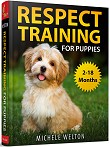 Respect Training For Puppies: 30 seconds to a calm, polite, well-behaved puppy is for puppies 2 to 18 months old. Your puppy will learn the 21 skills that all family dogs need to know. Click here to read for free.
Respect Training For Puppies: 30 seconds to a calm, polite, well-behaved puppy is for puppies 2 to 18 months old. Your puppy will learn the 21 skills that all family dogs need to know. Click here to read for free.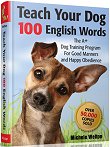 Teach Your Dog 100 English Words is a unique Vocabulary and Respect Training Program that will teach your adult dog to listen to you and do what you say. Click here to read for free.
Teach Your Dog 100 English Words is a unique Vocabulary and Respect Training Program that will teach your adult dog to listen to you and do what you say. Click here to read for free.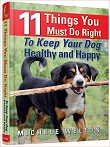 11 Things You Must Do Right To Keep Your Dog Healthy and Happy helps your dog live a longer, healthier life. Get my honest advice about all 11 Things before you bring home your new puppy, because some mistakes with early health care cannot be undone. Click here to read for free.
11 Things You Must Do Right To Keep Your Dog Healthy and Happy helps your dog live a longer, healthier life. Get my honest advice about all 11 Things before you bring home your new puppy, because some mistakes with early health care cannot be undone. Click here to read for free.
